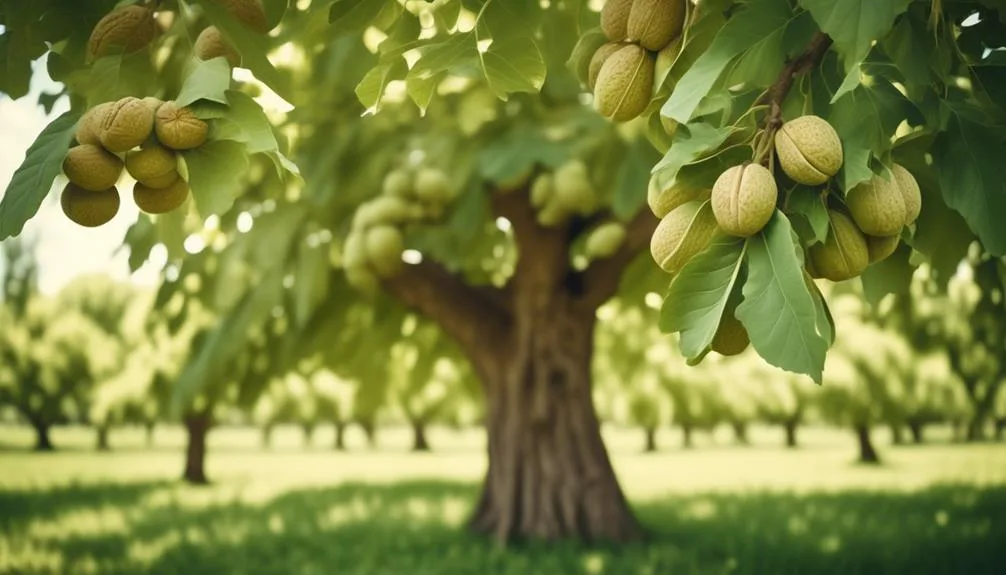Do you want your walnut tree to bear more fruit?
It can be tough, but with the right care, you can boost your walnut tree's yield. Proper pruning and soil management are key factors to consider.
Keep reading to learn the essential steps for helping your walnut trees thrive and produce a plentiful crop.
Key Takeaways
- Pruning techniques such as removing dead or diseased branches and retaining fruit-bearing wood on 2- to 5-year-old branches are important for encouraging walnut trees to bear fruit.
- Nutrient-rich soil with a pH level between 6.0 and 7.0, enriched with organic compost, is essential for healthy walnut tree growth and fruit production.
- Paying attention to blossom timing, attracting bees for effective pollination, and considering cross-pollination with different walnut tree varieties can improve fruit set.
- Regularly inspecting foliage for signs of infestation or infection, implementing integrated pest management strategies, and maintaining optimal soil conditions are crucial for managing pests and diseases and promoting fruit-bearing.
Proper Pruning Techniques
To encourage walnut trees to bear fruit, it's essential to master proper pruning techniques to ensure optimal growth and productivity. Understanding the branch structure and growth habits of walnut trees is crucial for effective pruning.
Start by removing dead or diseased branches to promote overall tree health. Identify and retain the fruit-bearing wood, which is typically located on 2- to 5-year-old branches. When making pruning cuts, ensure they're clean and angled to facilitate healing and discourage disease.
Additionally, thin out excessive growth to allow for better air circulation and light penetration, which can lead to increased fruit production. By following these proper pruning techniques, you can help your walnut trees develop a strong structure and maximize their fruit-bearing potential.
Nutrient-Rich Soil and Fertilization
Consider enriching the soil with essential nutrients and employing proper fertilization techniques to support the healthy growth and fruit-bearing potential of your walnut trees.
- Soil pH: Test the soil to ensure it has a slightly acidic pH level between 6.0 and 7.0, which is optimal for walnut trees.
- Organic Composting: Use organic compost to enrich the soil with essential nutrients, improving its fertility and structure.
- Watering Schedule: Implement a consistent watering schedule, ensuring that the soil remains moist but well-drained, especially during dry periods.
- Mulching Techniques: Apply a layer of organic mulch around the base of the tree to retain moisture, suppress weed growth, and provide additional nutrients to the soil.
Pollination and Cross-Pollination
Ensuring effective pollination is essential for maximizing the fruit-bearing potential of your walnut trees. Pay attention to blossom timing and weather conditions, as these factors play a crucial role in successful pollination. Walnut trees rely on wind and insects for pollination.
Bees are particularly effective pollinators, so consider attracting them to your garden by planting bee-friendly flowers. You may even want to consider beekeeping to ensure a steady supply of pollinators during the walnut tree's flowering period.
Be mindful of the weather, as cold or rainy conditions can hinder pollination. Cross-pollination between different walnut tree varieties can also improve fruit set.
Pest and Disease Management
When managing pests and diseases in your walnut trees, it's crucial to regularly inspect the foliage and monitor for any signs of infestation or infection.
To ensure the health of your walnut trees, consider the following pest and disease management strategies:
- Integrated Pest Management: Implement a combination of cultural, biological, and chemical control methods to manage pest populations effectively while minimizing environmental impact.
- Disease Resistance: Choose walnut tree varieties known for their resistance to common diseases prevalent in your region, such as anthracnose or bacterial blight.
- Pruning and Sanitation: Regularly prune and remove infected or infested branches to prevent the spread of diseases and reduce pest habitats.
- Soil Health: Maintain optimal soil conditions to promote tree vigor, as healthy trees are better equipped to withstand pest and disease pressures.
Seasonal Care and Maintenance
After implementing effective pest and disease management strategies, it's time to shift our focus to the seasonal care and maintenance of your walnut trees.
Maintaining a consistent watering schedule is crucial, especially during dry spells. Water deeply and infrequently, ensuring the soil remains moist but not waterlogged.
Apply a layer of mulch around the base of the tree to retain moisture, suppress weeds, and regulate soil temperature.
Additionally, monitor sun exposure and provide shade during extreme heat to prevent sunscald. Protect the trees from drastic temperature fluctuations by using tree wraps or painting the trunks with white latex paint to reflect sunlight.
Regularly inspect for signs of stress and adjust care practices accordingly.
Conclusion
Incorporate these essential techniques for encouraging walnut trees to bear fruit and watch your efforts come to fruition.
Through proper pruning, soil enrichment, pollination management, pest control, and seasonal care, you can foster healthy and productive walnut trees.
With these strategies in place, you're well-prepared to cultivate a thriving walnut harvest.
Happy growing!

